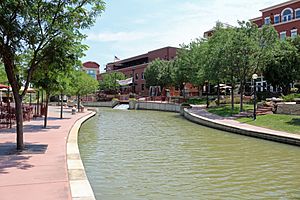Pueblo, Colorado facts for kids
Quick facts for kids
Pueblo, Colorado
|
||
|---|---|---|
| City of Pueblo | ||
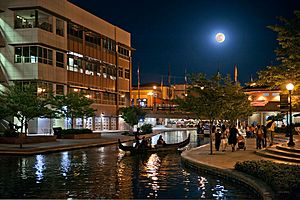
The Arkansas River Walk in Pueblo.
|
||
|
||
| Nickname(s):
Home of Heroes, Steel City
|
||
| Motto(s):
"A City Of Excellence"
|
||
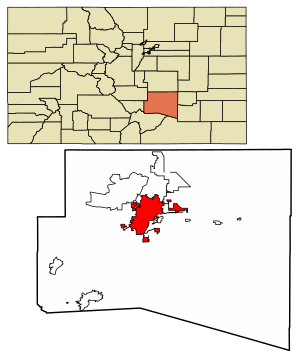
Location of the City of Pueblo in Pueblo County, Colorado.
|
||
| Country | ||
| State | ||
| County | Pueblo | |
| City | Pueblo | |
| Incorporated | November 15, 1885 | |
| Government | ||
| • Type | Home rule municipality | |
| • Body | Pueblo City Council | |
| Area | ||
| • Total | 56.083 sq mi (145.254 km2) | |
| • Land | 55.382 sq mi (143.439 km2) | |
| • Water | 0.701 sq mi (1.815 km2) | |
| Elevation | 4,692 ft (1,430 m) | |
| Population
(2020)
|
||
| • Total | 111,876 | |
| • Rank | 9th in Colorado 273rd in the United States |
|
| • Density | 2,020/sq mi (780/km2) | |
| • Metro | 168,162 (257th) | |
| • CSA | 217,690 (186th) | |
| • Front Range | 5,055,344 | |
| Demonym(s) | Puebloan | |
| Time zone | UTC−07:00 (MST) | |
| • Summer (DST) | UTC−06:00 (MDT) | |
| ZIP Codes |
81001-81012
|
|
| Area code(s) | 719 | |
| FIPS code | 08-62000 | |
| GNIS feature ID | 0204798 | |
| Major Routes | ||
| Website | pueblo.us | |
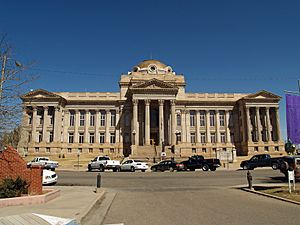
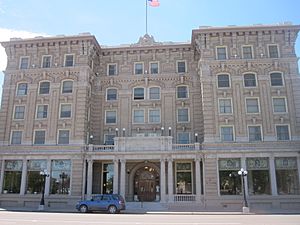
The City of Pueblo is the home rule municipality that is the county seat and the most populous municipality of Pueblo County, Colorado, United States. The city population was 111,876 at the 2020 United States Census, making Pueblo the ninth most populous city in Colorado. Pueblo is the principal city of the Pueblo, CO Metropolitan Statistical Area and a major city of the Front Range Urban Corridor.
Pueblo is situated at the confluence of the Arkansas River and Fountain Creek, 112 miles (180 km) south of the Colorado State Capitol in Denver. The area is considered semi-arid desert land, with approximately 12 inches (304.80 mm) of precipitation annually. With its location in the "Banana Belt", Pueblo tends to get less snow than the other major cities in Colorado.
Pueblo is one of the largest steel-producing cities in the United States, for which reason Pueblo is referred to as the "Steel City". The Historic Arkansas River Project (HARP) is a riverwalk in the Union Avenue Historic Commercial District, and shows the history of the devastating Pueblo Flood of 1921.
Pueblo has the least expensive residential real estate of all major cities in Colorado. The median home price for homes on the market in Pueblo is $192,500 as of April 2018. It is the sixth most affordable place to live in the United States as measured by the 2014 Cost of Living Index. Costs of housing, goods and services, utilities, transportation, groceries and health care are lower than the national average. Pueblo was listed by AARP in 2013 as one of the best affordable places to live.
Contents
History
Fort Pueblo
James Beckwourth, George Simpson, and other trappers such as Mathew Kinkead, claimed to have helped construct the plaza that became known as El Pueblo or Fort Pueblo around 1842. George married Juana Maria Suaso and lived there for a year or two before moving; however, Simpson had no legal title to the land. The adobe structures were built with the intention of settlement and trade next to the Arkansas River, which then formed the U.S./Mexico border. About a dozen families lived there, trading with Native American tribes for hides, skins, livestock, as well as (later) cultivated plants, and liquor. Evidence of this trade, as well as other utilitarian goods, such as Native American pottery shards were found at the recently excavated site. According to accounts of residents who traded at the plaza (including that of George Simpson), the fort was raided sometime between December 23 and December 25, 1854, by a war party of Utes and Jicarilla Apaches under the leadership of Tierra Blanca, a Ute chief. They allegedly killed between fifteen and nineteen men, as well as captured two children and one woman. The trading post was abandoned after the raid, but it became important again between 1858 and 1859 during the Colorado Gold Rush of 1859.
Pueblo's Early Development: Railroads, Steel, Expansion
The current city of Pueblo represents the consolidation of four towns: Pueblo (incorporated 1870), South Pueblo (incorporated 1873), Central Pueblo (incorporated 1882), and Bessemer (incorporated 1886). Pueblo, South Pueblo, and Central Pueblo legally consolidated as the City of Pueblo between March 9 and April 6, 1886. Bessemer joined Pueblo in 1894.
The consolidated city became a major economic and social center of Colorado, and was home to important early Colorado families such as the Thatchers, the Ormans, and the Adamses. By the early 1870s the city was being hailed as a beacon of development, with newspapers like the Chicago Tribune boasting of how the region's lawless reputation was giving way to orderly agriculture with triumphalist rhetoric. One author crowed of Pueblo that "the necessity exists no longer for Sharp's rifles and revolvers. These have been supplied by the plow and the mowing-machine."
Pueblo's development stretched beyond agriculture. Steel emerged as a key industry very early, and in 1909 the city was considered the only steel town west of the Mississippi River.
Until a series of major floods culminated in the Great Flood of 1921, Pueblo was considered the 'Saddle-Making capital of the World'. Roughly one-third of Pueblo's downtown businesses were lost in this flood, along with a substantial number of buildings. Pueblo struggled with this significant loss, but has had a resurgence in growth.
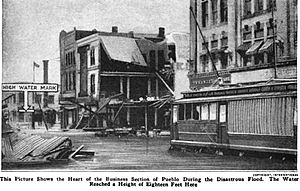
Steel Mill
The main industry in Pueblo for most of its history was the Colorado Fuel and Iron (CF&I) Steel Mill on the south side of town. For nearly a century the CF&I was the largest employer in the state of Colorado. The steel-market crash of 1982 led to the decline of the company. After several bankruptcies, the company was acquired by Oregon Steel Mills and changed its name to Rocky Mountain Steel Mills. The company was plagued with labor problems, mostly due to accusations of unfair labor practices. This culminated with a major strike in 1997, leading to most of the workforce being replaced.
In September 2004, both United Steelworkers locals 2102 and 3267 won the strike and the unfair labor practice charges. All of the striking steel workers returned to their jobs, and the company paid them the back pay owed for the seven years they were on strike. In 2007, shortly after Oregon Steel made amends with the union and its workers, Evraz Group, one of Russia's biggest steel producers, agreed to buy the company for $2.3 billion.
Of the many production and fabrication mills that once existed on the site, only the steel production (electric furnaces, used for scrap recycling), rail, rod, bar, and seamless tube mills are still in operation. The wire mill was sold in the late 1990s to Davis Wire, which still produces products such as fence and nails under the CF&I brand name.
The facility operated blast furnaces until 1982, when the steel market collapsed. The main blast furnace structures were torn down in 1989, but due to asbestos content, many of the adjacent stoves still remain. The stoves and foundations for some of the furnaces can be seen from Interstate 25, which runs parallel to the plant's west boundary.
Several of the administration buildings, including the main office building, dispensary, and tunnel gatehouse were purchased in 2003 by the Bessemer Historical Society. In 2006, they underwent renovation. In addition to housing the historic CF&I Archives, they also house the Steelworks Museum of Industry and Culture.
"Melting Pot of the West"
Due to the growth of the CF&I steel mill and the employment that it offered, Pueblo in the early twentieth century attracted a large number of immigrant laborers. The groups represented led to Pueblo becoming the most ethnically and culturally diverse city in Colorado and the West. At one point, more than 40 languages were spoken in the steel mill and more than two-dozen foreign language newspapers were published in the city. Irish, Italian, German, Slovenian, Greek, Jewish, Lithuanian, Russian, Hungarian, Japanese, and African-American groups arrived in the area at the turn of the century and remain to the present time. The convergence of cultures led to a cosmopolitan character to the city that resulted in a number of ethnically-rooted neighborhoods that are typically not seen west of the Mississippi. Respective cultural groups maintain cultural festivals to the present, with the city being home to locations of the Order Sons of Italy, American Slovenian Catholic Union, and I.O.O.F, among others.
Colorado Mental Health Institute at Pueblo
Another major employer in Pueblo is the Colorado State Hospital. The hospital is the preeminent mental health facility in the Rocky Mountain region. Established in 1879 as the Colorado State Insane Asylum, it was renamed as the Colorado State Hospital in 1917. In 1991, the name was changed to the Colorado Mental Health Institute at Pueblo (CMHIP). The Robert L. Hawkins High Security Forensic Institute opened in June 2009 and is a 200-bed, state-of-the-art high-security facility.
Home of Heroes
Pueblo is the hometown of four Medal of Honor recipients (more than any other municipality in the United States) - William J. Crawford, Carl L. Sitter, Raymond G. Murphy, and Drew D. Dix. President Dwight D. Eisenhower upon presenting Raymond G. "Jerry" Murphy with his medal in 1953 commented, "What is it... something in the water out there in Pueblo? All you guys turn out to be heroes!"
In 1993, Pueblo City Council adopted the tagline "Home of Heroes" for the city due to the fact that Pueblo can claim more recipients of the Medal per capita than any other city in the United States. On July 1, 1993, the Congressional Record recognized Pueblo as the "Home of Heroes." A memorial to the recipients of the medal is at the Pueblo Convention Center. Central High School is known as the "School of Heroes," as it is the alma mater of two recipients, Sitter and Crawford.
Geography
Pueblo is located at 38°16′1″N 104°37′13″W / 38.26694°N 104.62028°W (38.266933, −104.620393).
According to the United States Census Bureau, the city has a total area of 45.4 square miles (117.6 km2), of which, 45.1 square miles (116.8 km2) is land and 0.3 square miles (0.78 km2) is water (99.34% and 0.66% respectively).
Pueblo is 100 miles (160 km) south of Denver and is on the front range of the Rocky Mountains.
Climate
Pueblo sits in a high desert area of terrain in southern Colorado and is near the western edge of the Southwestern Tablelands ecology region. Pueblo has a steppe climate (Köppen BSk), with four distinct seasons. Winter days are usually mild, but the high does not surpass freezing on an average 15.3 days per year, and lows fall to 0 °F (−18 °C) or below on 7.8 nights. Snowfall usually falls in light amounts, and due to the high altitude, and the accompanying stronger sun, rarely remains on the ground for long. January is the snowiest month, followed by March, and the seasonal average is 31.8 inches (81 cm); however, snow is uncommon in October, and May or September snow is exceedingly rare, with an average first and last date of measurable (≥0.1 in or 0.25 cm) snowfall being November 6 and April 15, respectively. Summers are hot and dry, with 90 °F (32 °C) or greater highs are on average seen 66.7 days per year, with 100 °F (38 °C) or greater on 10.2 days. Diurnal temperature ranges are large throughout the year, averaging 33.4 °F (18.6 °C).
Precipitation is generally low, with the winter months receiving very little. Sunshine is abundant throughout the year, with an annual total of nearly 3470, or 78% of the possible total. Pueblo is considered a high desert climate, and sits on the desert lands in southern Colorado between Pueblo and the Royal Gorge.
| Climate data for Pueblo, Colorado (1981–2010 normals, extremes 1888–present) | |||||||||||||
|---|---|---|---|---|---|---|---|---|---|---|---|---|---|
| Month | Jan | Feb | Mar | Apr | May | Jun | Jul | Aug | Sep | Oct | Nov | Dec | Year |
| Record high °F (°C) | 81 (27) |
82 (28) |
86 (30) |
93 (34) |
102 (39) |
108 (42) |
109 (43) |
105 (41) |
101 (38) |
94 (34) |
85 (29) |
82 (28) |
109 (43) |
| Average high °F (°C) | 47.0 (8.3) |
50.5 (10.3) |
59.1 (15.1) |
67.2 (19.6) |
76.8 (24.9) |
87.2 (30.7) |
92.9 (33.8) |
89.4 (31.9) |
81.6 (27.6) |
69.4 (20.8) |
56.1 (13.4) |
46.0 (7.8) |
68.6 (20.3) |
| Daily mean °F (°C) | 30.5 (−0.8) |
33.9 (1.1) |
42.3 (5.7) |
50.6 (10.3) |
60.4 (15.8) |
70.0 (21.1) |
75.8 (24.3) |
73.4 (23.0) |
64.7 (18.2) |
51.8 (11.0) |
39.3 (4.1) |
30.1 (−1.1) |
51.9 (11.1) |
| Average low °F (°C) | 14.0 (−10.0) |
17.3 (−8.2) |
25.6 (−3.6) |
33.9 (1.1) |
44.1 (6.7) |
52.8 (11.6) |
58.7 (14.8) |
57.5 (14.2) |
47.7 (8.7) |
34.2 (1.2) |
22.5 (−5.3) |
14.2 (−9.9) |
35.2 (1.8) |
| Record low °F (°C) | −29 (−34) |
−31 (−35) |
−20 (−29) |
2 (−17) |
23 (−5) |
32 (0) |
41 (5) |
39 (4) |
21 (−6) |
−4 (−20) |
−17 (−27) |
−28 (−33) |
−31 (−35) |
| Average precipitation inches (mm) | 0.35 (8.9) |
0.30 (7.6) |
0.93 (24) |
1.40 (36) |
1.51 (38) |
1.36 (35) |
2.06 (52) |
2.32 (59) |
0.77 (20) |
0.72 (18) |
0.47 (12) |
0.38 (9.7) |
12.57 (319) |
| Average snowfall inches (cm) | 6.5 (17) |
3.8 (9.7) |
5.7 (14) |
3.8 (9.7) |
0.5 (1.3) |
0 (0) |
0 (0) |
0 (0) |
0.3 (0.76) |
1.3 (3.3) |
4.4 (11) |
5.5 (14) |
31.8 (81) |
| Average precipitation days | 4.0 | 3.7 | 6.3 | 6.6 | 7.9 | 7.1 | 9.1 | 9.5 | 5.6 | 4.1 | 3.9 | 4.1 | 71.9 |
| Average snowy days | 4.3 | 3.5 | 3.8 | 2.1 | 0.3 | 0 | 0 | 0 | 0.2 | 0.7 | 2.7 | 4.3 | 21.8 |
| Average relative humidity (%) | 57.1 | 52.1 | 48.7 | 43.5 | 44.6 | 44.9 | 49.3 | 51.5 | 50.2 | 47.0 | 57.1 | 56.6 | 50.2 |
| Mean monthly sunshine hours | 231.0 | 227.3 | 284.0 | 315.1 | 344.2 | 360.0 | 358.8 | 336.8 | 298.7 | 275.5 | 219.7 | 210.7 | 3,461.8 |
| Percent possible sunshine | 76 | 75 | 77 | 80 | 78 | 81 | 80 | 80 | 80 | 79 | 72 | 71 | 78 |
| Source: NOAA (relative humidity and sun 1961–1990) | |||||||||||||
Demographics
| Historical population | |||
|---|---|---|---|
| Census | Pop. | %± | |
| 1870 | 666 | — | |
| 1880 | 3,217 | 383.0% | |
| 1890 | 24,558 | 663.4% | |
| 1900 | 28,157 | 14.7% | |
| 1910 | 41,747 | 48.3% | |
| 1920 | 43,050 | 3.1% | |
| 1930 | 50,096 | 16.4% | |
| 1940 | 52,162 | 4.1% | |
| 1950 | 63,685 | 22.1% | |
| 1960 | 91,181 | 43.2% | |
| 1970 | 97,774 | 7.2% | |
| 1980 | 101,686 | 4.0% | |
| 1990 | 98,640 | −3.0% | |
| 2000 | 102,121 | 3.5% | |
| 2010 | 106,595 | 4.4% | |
| 2020 | 111,876 | 5.0% | |
| U.S. Decennial Census | |||
As of the census of 2000, there were 102,121 people, 40,307 households, and 26,118 families residing in the city. The population density was 2,265.5 people per square mile (874.6/km2). There were 43,121 housing units at an average density of 956.6 per square mile (369.3/km2). The racial makeup of the city was 56.21% White, 2.41% African American, 1.73% Native American, 0.67% Asian, 0.06% Pacific Islander, 15.20% from other races, and 3.71% from two or more races. Latinos made up 44.13% of the population. 10.1% were of German, 8.1% Italian, 6.0% American, 5.5% English and 5.4% Irish ancestry according to Census 2000.
According to the 2005 Census estimates, the city had grown to an estimated population of 104,951 and had become the ninth most populous city in the state of Colorado and the 245th most populous city in the United States.
There were 40,307 households, out of which 29.8% had children under the age of 18 living with them, 44.5% were married couples living together, 15.1% had a female householder with no husband present, and 35.2% were non-families. 30.0% of all households were made up of individuals, and 12.9% had someone living alone who was 65 years of age or older. The average household size was 2.44 and the average family size was 3.03.
In the city, the ages of the population were spread out, with 25.1% under the age of 18, 10.3% from 18 to 24, 26.6% from 25 to 44, 21.4% from 45 to 64, and 16.6% who were 65 years of age or older. The median age was 36 years. For every 100 females, there were 93.9 males. For every 100 females age 18 and over, there were 90.2 males.
The median income for a household in the city was $29,650, and the median income for a family was $35,620. Males had a median income of $29,702 versus $22,197 for females. The per capita income for the city was $16,026. About 13.9% of families and 17.8% of the population were below the poverty line, including 24.3% of those under age 18 and 9.1% of those age 65 or over.
As of the 2010 census, the population of Pueblo was 106,544 (259th most populous U.S. city), the population of the Pueblo Metropolitan Statistical Area was 159,063 (190th most populous MSA), the population of the Pueblo–Cañon City, CO Combined Statistical Area was 205,887, the population of the South Central Colorado Urban Area was 851,500, and the population of the Front Range Urban Corridor in Colorado was an estimated 4,166,855.
As of the April 2010 census the racial makeup of the city was: 75.2% White, 2.5% Black or African American, 2.2% American Indian and Alaska Native, 0.8% Asian, 0.1% Native Hawaiian and Other Pacific Islander, 4.1% Two or More Races. Hispanic or Latino (of any race) were 49.8% and Non-Hispanic Whites were 45.2% of the population.
Economy
Pueblo is the home of the Federal Citizen Information Center, operated by the General Services Administration, and its Consumer Information Catalog. For over 30 years, public service announcements invited Americans to write for information at "Pueblo, Colorado, 81009". In recent times GSA has incorporated Pueblo into FCIC's toll-free telephone number.
Vestas Wind Systems has constructed the largest (nearly 700,000 square feet) wind turbine tower manufacturing plant in the world at Pueblo's industrial park.
Renewable Energy Systems Americas broke ground on the Comanche Solar Project seven miles south of Pueblo in 2015. When complete, it will be the largest solar energy farm east of the Rocky Mountains, and its backers say the project will produce electricity more cheaply than natural gas. The project will cover 1,000 acres with 500,000 solar panels, providing a capacity of 156 megawatts of power—enough to supply 31,000 homes. The project will be run by SunEdison, with a power purchase agreement signed by Xcel Energy. A number of scientific studies now list Pueblo as the state's primary locale for solar energy development and the premier setting for solar companies to locate, placing it ahead of regional rivals such as Boulder, Colorado and Taos, New Mexico.
In February 2017, Pueblo City Council voted to commit the city to 100% renewable energy ("Ready for 100%") by 2035, with the city's electric franchisee, Black Hills Energy, expected to ramp up its renewable energy portfolio from 29% to 65%. Pueblo County commissioners joined the renewable commitment in April 2018. For several years, Pueblo's Energy Future has been pushing the city to become a municipal electric provider. Among the claimed advantages for the move toward independence: lower cost to the consumer, increased reliability and the opportunity to move more aggressively toward renewable energy development. At one time, an August 2020 "divorce" seemed possible.
Retail
The city's main retail center is Pueblo Mall, built in 1976.
- Top employers
According to Pueblo's 2017 Comprehensive Annual Financial Report, the top employers in the city are:
| # | Employer | # of employees |
|---|---|---|
| 1 | Parkview Medical Center | 2,900 |
| 2 | Pueblo School District 60 | 1,840 |
| 3 | Colorado Mental Health Institute at Pueblo | 1,200 |
| 4 | Pueblo County | 1,106 |
| 5 | Pueblo County School District 70 | 1,101 |
| 6 | Walmart|style="text-align:center"|1,035 | |
| 7 | Evraz Steel Mills | 979 |
| 8 | Vestas | 967 |
| 9 | St. Mary-Corwin Medical Center | 934 |
| 10 | City of Pueblo | 733 |
| *Includes all stores and management in Pueblo County | ||
Arts and culture
Pueblo is the home to Colorado's largest single event, the Colorado State Fair, held annually in the late summer, and the largest parade, the state fair parade, as well as an annual Chile & Frijoles Festival.
Tourism
- Buell Children's Museum
- Pueblo Convention Center
- Pueblo Memorial Hall
- City Park Carousel
- El Pueblo History Museum
- Lake Pueblo State Park
- Nature and Raptor Center of Pueblo
- Pueblo Ice Arena
- Pueblo Zoo
- Steelworks Museum of Industry and Culture managed by the Steelworks Center of the West
- Union Avenue Historic Commercial District
- Weisbrod Aircraft Museum
Transportation
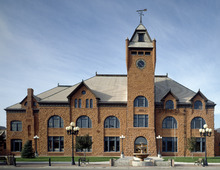
Local and regional buses
The City of Pueblo operates Pueblo Transit. Greyhound Lines provides bus service towards Denver, Colorado; Amarillo, Texas; Albuquerque, New Mexico. Regional bus service to La Junta, Lamar as well as Colorado Springs is provided by the CDOT operated Bustang.
Rail
Freight rail service is provided by BNSF and Union Pacific. Pueblo and its Union Depot last saw passenger train service in 1971.
Amtrak's daily Southwest Chief stops 64 miles (103 km) east of Pueblo at La Junta, providing direct rail transport to Los Angeles, Albuquerque, Kansas City, Chicago, and dozens of smaller locales. In 2016, Amtrak looked at rerouting the Southwest Chief to serve Pueblo directly. It estimated the new stop would increase annual ridership by 14,000 and ticket revenue by $1.45 million.
Pueblo has been proposed as the southern terminus for Front Range Passenger Rail, which would provide service to Colorado Springs, Denver, Boulder, Fort Collins, and Cheyenne.
Aviation
- Pueblo Memorial Airport - The local airport lies to the east of the city. Throughout the year, aircraft spotters can see large C-130, C-17, and E-3 performing landings and takeoffs. Modern fighters such as the F-22, F-15, F-35, and F-16 are also seen on occasion flying around the facility and parked on the ramp. SkyWest Airlines under the flag of United Express services the airport with non-stop daily flights to Denver International Airport, utilizing Bombardier's CRJ-200 aircraft. The airport is also home to the Pueblo Weisbrod Aircraft Museum (named for Fred Weisbrod, late city manager), reflecting the airport's beginnings as an Army Air Corps base in 1943.
- Pueblo Historical Aircraft Society
- Fremont County Airport is a general aviation field approximately 35 miles north-west of Pueblo, near Penrose.
Major highways
![]() Interstate 25 and
Interstate 25 and ![]() US Route 85 run in tandem on the same north–south expressway through Pueblo.
US Route 85 run in tandem on the same north–south expressway through Pueblo. ![]() US Route 50 runs east–west through Pueblo.
US Route 50 runs east–west through Pueblo.
Pueblo in popular culture
- Pueblo as a frontier town is the setting for Louis L'Amour's 1981 western novel Milo Talon.
- Many of the scenes in Terrence Malick's 1973 opus Badlands were filmed in and around Pueblo. The film was subsequently selected for preservation by the Library of Congress as being "culturally, historically, or aesthetically significant".
- The Italian-American protagonist of John Fante's celebrated 1939 poetic novel Ask the Dust, adapted into a film version by Robert Towne in 2006, is from Pueblo.
- Pueblo and its Central High School is mentioned in Thomas Pynchon's 2006 historical novel Against the Day.
- The Food Network show Unwrapped is often shot in Pueblo.
- Food Wars, a series on cable television's Travel Channel, came to Pueblo to stage a contest between the Sunset Inn's and Gray's Coors Tavern's versions of the slopper. The episode first aired in August 2010.
- Pueblo is portrayed as the city where MacGruber is laid to rest in 2000 in the 2010 film that bears his name.
- In the South Park episode "The Losing Edge", Pueblo is one of the towns with which the South Park team competes.
- Pueblo is mentioned in the song "Stuart" by the satirical punk rock band Dead Milkmen, as the source of the pamphlet entitled "Do you know what the queers are doing to our soil?".
- Pueblo is portrayed as a ghostly, radiated ruin in the Darwin's World novel Burning Lands.
- Many of the Colorado and Kansas scenes of the 1983 film National Lampoon's Vacation were filmed in and around Pueblo. Highway 50 East of Pueblo is the site of Cousin Eddie's house and the hotel in "Creede" Colorado is actually near St. Mary Corwin Hospital.
- The 1980s film Curse of the Blue Lights was set in Pueblo and was filmed on location.
Twin towns – Sister cities
 Weifang, China
Weifang, China Bergamo, Italy
Bergamo, Italy Lucca Sicula, Italy
Lucca Sicula, Italy Chihuahua, Mexico
Chihuahua, Mexico Puebla, Mexico
Puebla, Mexico Maribor, Slovenia
Maribor, Slovenia
Sports
Pueblo is the hometown of Dutch Clark, the first man from Colorado inducted into the Pro Football Hall of Fame as well as the Colorado Sports Hall of Fame. The primary football stadium belonging to Pueblo School District 60 is named for him. Two long-standing high school rivalries are played annually at this stadium. The Bell Game has been played annually since 1892 between the Central Wildcats and the Centennial Bulldogs in what is touted as the oldest football rivalry west of the Mississippi River.
In 2008, Professional Bull Riders (PBR) moved its corporate headquarters to Pueblo. This became the site of their world headquarters based at the Historic Arkansas Riverwalk located bordering the Union Avenue Historic Commercial District.
In 2014, the Colorado State University Pueblo ThunderWolves won the NCAA Division II Football Championship, a first national title for the football program.
In 2019, the Pueblo Bulls junior ice hockey team in the United States Premier Hockey League, began play out of the Pueblo Ice Arena.
Education
Higher education
Pueblo is home to Colorado State University Pueblo (CSU Pueblo), a regional comprehensive university. It is part of the Colorado State University System (CSU System), with about 4,500 students. On May 8, 2007, CSU Pueblo received approval from the Board of Governors of the Colorado State University System to bring back football as a member of the Rocky Mountain Athletic Conference. The first game was played in the fall of 2008 at the ThunderBowl, a stadium at CSU Pueblo for over 12,000 spectators. In 2014, the football team won the NCAA Division II Football Championship.
Pueblo Community College (PCC) is a two-year, public, comprehensive community college, one of thirteen community colleges within the Colorado Community College System (CCCS). It operates three campuses serving a widely dispersed eight-county region in Southern Colorado. The main campus is located in Pueblo and serves Pueblo County. The Fremont Campus is located approximately 35 miles (56 km) west of Pueblo in Cañon City and serves Fremont and Custer Counties. The Southwest Campus, 280 miles (450 km) southwest of Pueblo, serves Montezuma, Dolores, La Plata, San Juan, and Archuleta counties. PCC is a Hispanic Serving Institution as designated by the Federal Government. Approximately 5,000 students attend PCC per semester.
Primary and secondary education
Almost all of the city limits is within Pueblo School District 60. Very small portions lie within Pueblo County School District 70.
Centennial High School was founded north of downtown on Eleventh Street in 1876, the year Colorado entered the Union. Centennial was rebuilt on a new site to the northwest in 1973. Central High School was founded in Bessemer in 1882. Central's present campus on East Orman Avenue was built in 1906 and expanded in the early 1970s. Its original building still stands four blocks away on East Pitkin Avenue. South High School and East High School were built in the late 1950s to accommodate the Baby Boomer generation. Pueblo County High School, east of the city in Vineland, serves rural residents. Rye High School is in a foothills town southwest of Pueblo. Pueblo West High School is located in the northwestern suburb of Pueblo West.
Pueblo Catholic High School closed in 1971. Its building became Roncalli middle school in the early 1970s. By 1975 all Catholic schools in Pueblo (under the Roman Catholic Diocese of Pueblo) had closed. As of 2017[update] there are two Catholic grade schools in Pueblo: St. John Neumann Catholic School and St. Therese Catholic School.
Dolores Huerta Preparatory High School was founded in 2004, and relocated to its current building in 2007. It features the only Early College Program in Pueblo recognized by the State of Colorado, where many students graduate with their associate degree from Pueblo Community College while also earning credit from Colorado State University Pueblo. Other Pueblo area high schools include Southern Colorado Early College, School of Engineering and Biomedical Science (formerly Pueblo Technical Academy), Parkhill Christian Academy and the Health Academy.
Notable people
Military
- William J. Crawford, Medal of Honor recipient for his service in World War II
- Warren C. Dockum, Medal of Honor recipient for service in the American Civil War. Buried in Pueblo
- Drew Dennis Dix, Medal of Honor recipient for service in the Vietnam War
- Raymond G. Murphy, Medal of Honor recipient for service in the Korean War
- Carl L. Sitter, Medal of Honor recipient for service in the Korean War
- Robert M. Stillman, U.S. Air Force general
- Cathay Williams, first African-American woman to enlist in the United States Army, and the only person documented to have served while posing as a man
Business
- Ed Beauvais, airline executive
- Jim Bishop, creator of Bishop Castle
- Nona L. Brooks, leader in the New Thought movement and a founder of the Church of Divine Science
- Dan DeRose, businessman and college football player
- Charles Goodnight, legendary Texas cattleman, lived in Pueblo in the 1870s
- Benjamin Guggenheim, businessman who lived in Pueblo from 1888 to 1894, perished aboard the Titanic in 1912
- David Packard, co-founder of Hewlett-Packard computers, considered the "Father of Silicon Valley", Graduated from Pueblo Centennial High School
- William Jackson Palmer, founder of Colorado Fuel and Iron and the Denver and Rio Grande Railroad
Arts
- Kent Haruf, novelist, born in Pueblo
- Dustin Hodge, television writer and producer, lives in Pueblo
- Bat Masterson, newspaperman, former sheriff of South Pueblo
- John Meston, co-creator and script writer of CBS Western television series Gunsmoke
- E. J. Peaker, actress, star of Hello Dolly, graduated from Centennial High School in 1958
- Blaine L. Reininger, singer and musician of proto-punk and new wave, co-founder of Tuxedomoon
- Kelly Reno, child actor in the 1979 film The Black Stallion and its sequel
- Charles Rocket, Saturday Night Live cast member, formerly a news anchor in Pueblo
- Dan Rowan, star of Rowan & Martin's Laugh-In, lived in McClelland Orphanage in Pueblo and graduated from Pueblo Central High School
- Damon Runyon, newspaperman and playwright; author of Guys and Dolls. Mentioned Pueblo in many of his newspaper columns
- Connie Sawyer, actress
- Rose Siggins, actress
- Lise Simms, actress, singer, designer and dancer
- Margaret Tracey, ballet dancer and educator
- Wanda Tuchock, writer, producer, film pioneer
- Mildred Cozzens Turner, composer
- Michael K. White, writer
- Grant Withers, Hollywood actor from the silents to the 1950s
- Ledger Wood, philosopher
Sports
- Dax Charles, Division II National Wrestling Champion competing for University of Southern Colorado now known as CSU Pueblo, CSU Pueblo Wrestling Coach
- Earl (Dutch) Clark, professional football player 1934–1938, charter member of Pro Football Hall of Fame, graduated from Pueblo Central High School
- John Davis, Major League Baseball pitcher (1987–1990)
- Tony Falkenstein, pro football fullback and quarterback
- Dave Feamster, ice hockey player who played for the Chicago Blackhawks and businessman
- John Gill, climber, father of modern bouldering; taught at University of Southern Colorado (CSU Pueblo)
- Luke Hochevar, Major League Baseball pitcher (2007–present). Raised in Fowler, Colorado
- Kimberly Kim, professional golfer, youngest player to win the U.S. Women's Amateur
- Gary Knafelc, professional football player (1954–1963)
- Turk Lown, Major League Baseball pitcher (1951–1962)
- Bob McGraw, Major League Baseball pitcher (1917–1929), buried in Pueblo
- Tony Mendes, PBR bull rider
- Joe Pannunzio, college football administrator, player and coach.
- Frank Papish, Major League Baseball pitcher (1945 to 1950); deputy sheriff after baseball career
- Ken Ramos, Major League Baseball outfielder
- Marty Servo, boxing Welterweight Champion of the World, retired to Pueblo
- Kory Sperry, NFL tight end; attended Pueblo County High School
- Cedric Tillman, professional football player
- George Zaharias, professional wrestler, husband of Babe Didrikson
Infamous figures
Other
- Mary Babnik Brown, donated her hair during World War II for the manufacture of hygrometers (hair falsely reported to have been used to make Norden bombsights)
- Virginia Tighe, housewife purported to have lived as an Irishwoman named Bridey Murphy in a previous life
See also
 In Spanish: Pueblo (Colorado) para niños
In Spanish: Pueblo (Colorado) para niños




